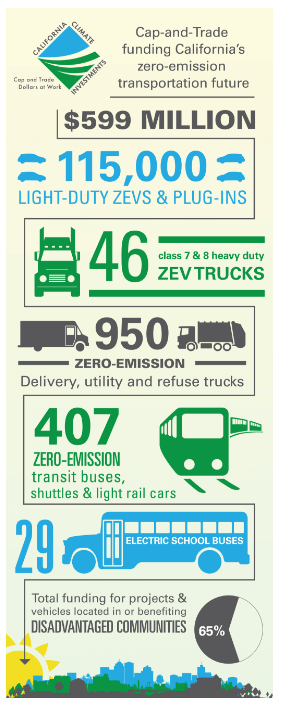At the 2017 ACT Expo in Long Beach, the California Air Resources Board (CARB) announced that California Climate Investments in zero-emission vehicles have reached $599 million since 2013, putting hundreds of thousands of ultra-clean cars, and entire fleets of zero-emission trucks and buses on California roads and highways.
“Investing in zero-emission cars, trucks and buses is a smart and effective use of cap-and-trade proceeds,” says CARB Chair Mary D. Nichols. “It generates thousands of clean-tech jobs in California, helps bring these ultra-clean vehicles to market sooner, and places them in the communities that have the greatest need of clean air.”
According to CARB, the funding is from California Climate Investments, a statewide program that puts billions of cap-and-trade dollars to work reducing greenhouse-gas emissions, strengthening the economy and improving public health and the environment — particularly in disadvantaged communities.
Since the transportation sector overall is the largest contributor to the state’s total annual greenhouse-gas emissions, a major focus of the climate investment program has been supporting the development and deployment of next-generation zero-emission trucks, cars and buses.
As reported, the investments support a wide range of next-generation vehicles, including electric school buses in Sacramento, electric yard trucks in Fontana, hydrogen-powered buses in the Coachella Valley, and a fleet of electric delivery trucks for Goodwill Industries in the Bay Area. More than 65% of the investments are for projects or vehicles that are in, or benefit, disadvantaged communities.
One major focus of these investments is to accelerate the market for the next generation of clean, heavy-duty trucks and buses, both those that run on electricity and on hydrogen. Several are demonstration projects, such as putting newly built zero-emission trucks to work side-by-side with existing diesel trucks in rail yards or distribution centers to fully determine their benefits and capabilities in those demanding work environments.
In many cases, it is estimated that the overall operating costs of the zero-emission trucks and buses will be less than fossil-fuel powered trucks over the life of the vehicle because of lower fuel and maintenance costs. The California Climate Investments are designed to help drive down the upfront purchase price of the cleaner zero-emission trucks, and as their numbers increase, that cost will drop even further due to economies of scale.
Another goal of these investments is to support the market for zero-emission cars throughout the state and making them available to residents of low-income communities. Thanks to the state’s zero-emission regulation and incentives, California – with 283,000 zero-emission and plug-in vehicles to date – comprises more than 40% of national zero-emission car sales, even though the state has only 10% of the nation’s population.
CARB notes that many of these cars, trucks and buses are built in California. Tesla, which manufactures electric cars in the Bay Area; BYD, which builds buses in Lancaster; and Proterra, which builds zero-emission vehicles in the city of Industry, together employ more than 12,000 workers building the cars and buses that are helping to clean California’s air and fight climate change.
The cap-and-trade program also creates a financial incentive for industries to invest in clean technologies and develop innovative ways to reduce pollution. California Climate Investments projects include affordable housing, renewable energy, public transportation, zero-emission vehicles, environmental restoration, more sustainable agriculture, recycling and much more.
CARB says at least 35% of these investments are made in disadvantaged and low-income communities.
$599 Million Cap-and-Trade Investments in California’s Zero-Emission Transportation Future
Cars:
- 115,000 light-duty ZEVs and PHEVs
- Full battery electric cars – 71,000
- Plug-in hybrid cars – 43,000
- Hydrogen fuel cell cars – 1,000
Heavy-duty trucks:
- 46 Class 7+8 zero-emission trucks
Delivery, utility, trash trucks:
- 950 delivery, utility and refuse trucks
- Utility trucks – 107
- Hybrid delivery, refuse trucks– 732
- Battery-electric delivery trucks – 111
Transit and light rail:
- 407 zero-emission transit buses, shuttles and light rail cars
- Transit buses – 309
- Shuttle buses – 68
- Light rail – 30
School buses:
- 29 electric school buses
Off-road, cargo-handling equipment:
- 46 zero-emission yard trucks, fork lifts, cargo-handling equipment
For more information about California’s investment in low carbon vehicles and transportation, click here.





